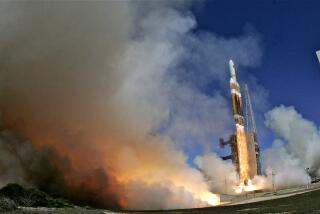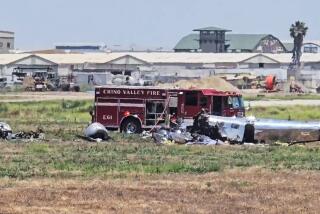Chinese Pilot Says U.S. Plane Abruptly Swerved Into His Partner’s Path
- Share via
BEIJING — A Chinese pilot on Friday angrily described seeing a U.S. spy plane turn into the path of his partner’s fighter jet, sending the Chinese aircraft plunging out of control.
The other airman is missing and presumed dead after bailing out Sunday over the South China Sea.
Interviewed on Chinese national television about an incident that has strained relations between the United States and China, pilot Zhao Yu described how he and partner Wang Wei took off at 8:45 a.m. Sunday in two F-8 fighters to track the U.S. Navy EP-3 reconnaissance plane near China’s southern coast.
Zhao, dressed for his TV appearance in his dark blue aviator’s uniform, said the U.S. plane changed course twice and the Chinese pilots adjusted their flight paths accordingly. At 9:05 a.m., “we were flying at the same speed and the same direction as the U.S. spy plane,” which was about 1,300 feet away, he said.
But two minutes later, “the U.S. plane suddenly swerved at a wide angle toward our direction,” Zhao said. The nose and left wing of the EP-3 and its left outer propeller hit the vertical tail surface of Wang’s plane, he said.
In a separate interview with the official New China News Agency, Zhao said that, after the collision, he told his partner to try to stay on course despite the battered tail section.
Thirty seconds later, Wang requested permission to bail out, Zhao said.
“I said OK, then I lost radio contact with him,” Zhao said. The crippled jet plunged into the sea, and Zhao said he saw Wang’s parachute far below.
Zhao tried to determine Wang’s position and then returned to Lingshui military air base on China’s Hainan island, about 65 miles away. The damaged EP-3 made an emergency landing at the field 10 minutes later. The 24 crew members of the U.S. plane have been held on the island since Sunday.
“The U.S. side is fully responsible for this collision,” said Zhao, echoing the Chinese government’s position on the incident. The EP-3’s abrupt change in course made it “impossible to avoid it,” he said.
“The U.S. plane severely violated flying rules, so they should take full responsibility,” Zhao said, at times gesturing angrily during the television interview. “I am indignant at the actions of the U.S. spy plane crashing our plane right at our doorstep.”
U.S. defense officials have suggested that Wang caused the collision by flying too close to the slower-moving EP-3. They also have charged that the Chinese pilot was a “cowboy” who had a history of flying too close to U.S. aircraft.
But Wang was being lionized as a hero and an “outstanding squadron leader” in the Beijing media Friday, which his parents said was his 33rd birthday.
Chinese officials told The Times that Wang was a lieutenant commander in the Chinese navy. He entered the military in June 1986, when he was 18, and graduated--perhaps from flight school, though it was not made clear--in June 1991.
He was classified as able to fly in four types of weather and had logged more than 1,100 hours of flight time, the officials said.
More to Read
Sign up for Essential California
The most important California stories and recommendations in your inbox every morning.
You may occasionally receive promotional content from the Los Angeles Times.













